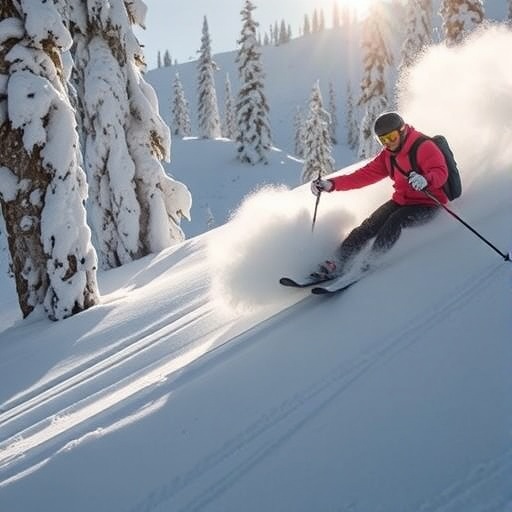
In a groundbreaking study published in Sports Engineering, researchers have delved into the intricate relationship between load, pulling speed, and the static coefficient of friction of cross-country skis on snow. The study, conducted by a team of experts, including Quirion Cantin, Lépine, and Bégin-Drolet, sheds light on crucial factors that can significantly influence performance in skiing, an activity that combines both technique and science.
Understanding the dynamics of ski performance is paramount for athletes, trainers, and equipment manufacturers alike. In a sport where milliseconds can make or break an Olympic-level race, the efficiencies of equipment become vital. This research specifically focuses on how varying the load on skis and the speed at which they are pulled affects their interaction with the snow, which is a contributing factor to overall energy expenditure and speed.
The static coefficient of friction is essential in determining how well the skiing equipment interacts with the snow surface. High friction can slow down performance while low friction can lead to a loss of control. Therefore, comprehending these coefficients under different conditions is key for optimizing skiing strategies, helping athletes to select the right skis and techniques for the specific conditions they may encounter.
The researchers conducted extensive experiments to ascertain the effects of load and pulling speed on the static coefficient of friction. Through their meticulously designed trials, they were able to measure the forces at play between the skis and the snow, revealing how different weights can dramatically change performance outcomes. The study highlights the importance of maintaining an optimal load during skiing, as overloading or underloading can significantly alter the friction encountered, ultimately affecting speed and technique.
Another critical aspect of the study was the pulling speed, as it closely simulates the dynamic conditions faced by athletes during competition. The findings indicated that the rate at which skis are pulled across the snow surface influences friction levels considerably. A faster pulling speed typically resulted in reduced friction, demonstrating that athletes may be able to achieve greater speeds with an efficient technique that accounts for this variable. Furthermore, the research suggests that athletes might need to adjust their approach based on the snow conditions, taking into account whether they will be competing in icy, packed snow or softer, powdery terrain.
Moreover, this research prompts a re-evaluation of conventional training and skiing modalities. Athletes and coaches can leverage these insights to refine their training regimens, focusing not just on strength and endurance but also on the nuances of ski load management. Training programs may need to incorporate simulations that involve varying loads and speeds to develop optimal strategies tailored specifically for competitive scenarios.
This study also raises questions about equipment design. Ski manufacturers may need to innovate their products based on the findings related to friction coefficients. By understanding how different materials and designs perform under varying loads and speeds, manufacturers may be able to create skis that are lightweight yet capable of maintaining an optimal connection with the snow. This balance of performance and technology could yield significant advancements in competitive skiing gear.
Furthermore, the implications of this study extend beyond just competitive skiing. Recreational athletes, winter sports enthusiasts, and even beginners can benefit from this research. By being informed about how loads and speeds impact their skiing experience, skiers across the board can enhance their abilities and enjoy their time on the snow more efficiently.
The research also emphasizes the importance of continued exploration in the field of sports engineering. Gaining deeper insights into the friction dynamics involved in skiing opens up new avenues for research that could encompass other winter sports, analyzing how different factors contribute to athlete performance. Such knowledge could stimulate innovation across various sports, driving advancements that make them safer, more competitive, and ultimately more enjoyable.
In conclusion, the study conducted by Cantin, Lépine, and Bégin-Drolet is a significant contribution to the field of sports science, particularly for winter sports. By elucidating the effects of load and pulling speed on the static coefficient of friction in cross-country skiing, they provide essential insights that can influence training regimens, equipment design, and even recreational skiing experiences. As the skiing community continues to evolve, embracing the marriage of science and sport may pave the way for new records and exceptional achievements on the snow.
Increasing awareness of these findings will undoubtedly lead to discussions among athletes and trainers, sparking a movement towards more informed practices in skiing. As the study unfolds in both competitive scenarios and training environments, it has the potential to redefine performance standards and athlete preparation for years to come.
Subject of Research: The relationship between load, pulling speed, and the static coefficient of friction of cross-country skis on snow.
Article Title: Effect of load and pulling speed on the static coefficient of friction of cross-country skis on snow.
Article References: Quirion Cantin, N., Lépine, J. & Bégin-Drolet, A. Effect of load and pulling speed on the static coefficient of friction of cross-country skis on snow.
Sports Eng 27, 37 (2024). https://doi.org/10.1007/s12283-024-00479-z
Image Credits: AI Generated
DOI:
Keywords: Cross-country skiing, static coefficient of friction, load, pulling speed, sports engineering.
Tags: cross-country ski dynamicseffects of friction on ski performanceenergy expenditure in skiingequipment efficiency in competitive skiingfactors influencing cross-country skiingimpact of load on ski speedload-speed relationship in skiingOlympic skiing technique analysisski performance optimizationskiing research and sports engineeringsnow interaction with skiing equipmentstatic coefficient of friction in skiing




